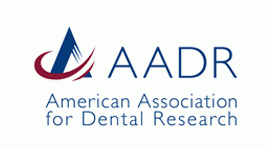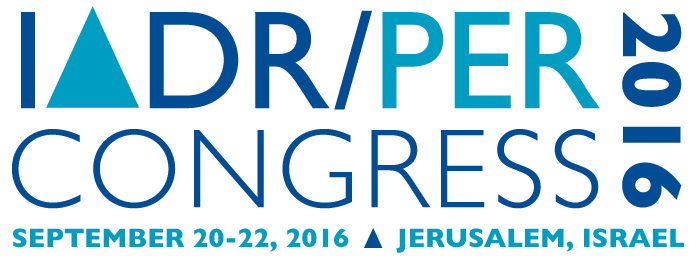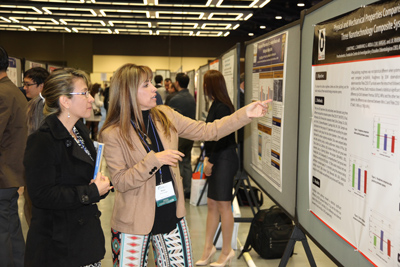Abstract notifications for the 2016 AADR/CADR Annual Meeting were sent out on December 9, 2015 to PRESENTERS ONLY. If you did not receive your notification, please log into your ScholarOne Abstracts account to access to Message Center.
Presentation Times
Presenter Guidelines
Poster Design
POSTER SIZE
 The board will be used VERTICALLY. Dimensions of the poster board are 7 feet high by 3 feet wide. These are the maximum dimensions to follow when creating your poster, but you make your poster smaller
The board will be used VERTICALLY. Dimensions of the poster board are 7 feet high by 3 feet wide. These are the maximum dimensions to follow when creating your poster, but you make your poster smaller
Include your PRESENTATION # once you receive it (approximately 1 week after the presenter pre-registration deadline) in the top right corner in your poster materials. The number should be large enough for people to quickly identify your poster as they are walking down the aisles.
POSTER PRESENTATION TIMES
| Presentations Scheduled on |
Mount Posters |
Poster Viewing Time |
Remove Posters |
| Thursday, March 17
Block 1: 2 p.m. – 3:15 p.m.
Block 2: 3:30 p.m. – 4:45 p.m. |
Thursday, March 17
7:30 a.m. – 8 a.m. |
Thursday, March 17
8 a.m. – 5 p.m. |
Thursday, March 17
5 p.m. – 5:15 p.m. |
| Friday, March 18
Block 1: 2 p.m. – 3:15 p.m.
Block 2: 3:30 p.m. – 4:45 p.m. |
Friday, March 18
7:30 a.m. – 8 a.m. |
Friday, March 18
8 a.m. – 5 p.m. |
Friday, March 18
5 p.m. – 5:15 p.m. |
| Saturday, March 19
Block 1: 10:45 a.m. – 12 p.m.
Block 2: 12:15 p.m. – 1:30 p.m.. |
Saturday, March 19
7:30 a.m. – 8 a.m. |
Saturday, March 19
8:30 a.m. – 1:45 p.m. |
Saturday, March 19
1:15 p.m. – 2:15 p.m. |
POSTER PRESENTATION GUIDELINES
- In late January, after the presenter pre-registration deadline, you will receive your PRESENTATION NUMBER for your poster presentation. The Presentation Number will be used to locate your poster board in the poster/exhibition hall by Meeting Delegates. The Presentation Number identifies your poster in the Program Book, online program and meeting app. You must incorporate your Presentation Number into your poster display.
- During poster set-up, look for your presentation number on the side of the poster board. DO NOT remove the number sign, since others will need to use that information to find their poster location throughout the meeting.
- Secure a Poster Presenter ribbon on site to wear during the meeting. This ribbon will allow you access to the poster/exhibition hall to set up and tear down your poster then when the hall is closed. You will not be allowed entrance into the exhibition hall without the proper ribbon.
- Friends and colleagues cannot set up your poster for you.
- You are required to stay at your poster at your assigned presentation time only. You are not required to during the entire viewing time. The AADR keeps track of no-shows, or presenters that are not at their poster for the duration of the session. Co-authors and/or mentors may be available to assist in answering questions, however, they may not present the paper.
- Posters must remain up until the time specified.
- The IADR will not be responsible for posters and materials left on poster boards after the stated hours.
- You must set up and tear down your poster during the designated times. No exceptions will be allowed.
- You must be knowledgeable in your subject and answer questions during your presentation.
- If you are both a symposium speaker and a poster presenter at this meeting do not repeat symposium material in your individual presentation.
- If applicable, presenters should mention the sponsors of their research in their presentation.
- Presenters may have copies of their presentation available as handouts. This is not mandatory, just an option for the presenter to increase the impact of the presentation.
POSTER DESIGN
The presentation must cover the same material as the abstract submitted. Use the following instructions
- Presentation number of the abstract, title and author(s) must be included on the poster.
- You may display your figures, tables, text, photography, etc. in the best manner for your abstract. Figures should be designed to be viewed from a distance and should use clear, visible graphics and large type. Color can be effective if used sparingly; use saturated dark colors on white background and rich, bright colors on dark backgrounds.
- Briefly describe procedures and materials. Define all trade names first then use generic names throughout. All compounds and drugs must be identified.
- Prepare all illustrations neatly and legibly beforehand in a size sufficient to be read at a distance of 8 feet (240 cm). Hand-lettering should be at least 3.8 inch (I cm) high. Shade block letters if possible. Typed material should be prepared with large type.
- A series of typewritten sheets attached to the poster board is not an acceptable poster.
- It is helpful if the sequence to be followed is indicated by number, letter, or arrows.
- Please do not write or paint on the poster board.
- Attach a small photograph of yourself to the poster so other participants can recognize you as the presenter
QUICK RESPONSE (QR) CODES
Though not required, IADR permits you to create and use QR codes in conjunction with your poster as a method of sharing more information with meeting delegated.
IADR will have a smartphone application for the meeting. In conjunction with the AADR Annual Meeting app, we will have Quick Response (QR) codes in the Program Book and on several meeting signs. QR codes are two-dimensional bar codes that are intended for rapid decoding of content. Through the use of a QR code reader, these codes can be scanned by smartphone users to secure the encoded information. QR codes can contain URLs, contact information, coordinates, email addresses, phone numbers, SMS messages and even just plain text.
Please visit your Android, Apple or BlackBerry mobile device’s application store to find the QR reader for your specific device. To create a QR code, enter “QR Code Generator” into your search engine to find the right one for you.




 The board will be used VERTICALLY. Dimensions of the poster board are 7 feet high by 3 feet wide. These are the maximum dimensions to follow when creating your poster, but you make your poster smaller
The board will be used VERTICALLY. Dimensions of the poster board are 7 feet high by 3 feet wide. These are the maximum dimensions to follow when creating your poster, but you make your poster smaller






Share: